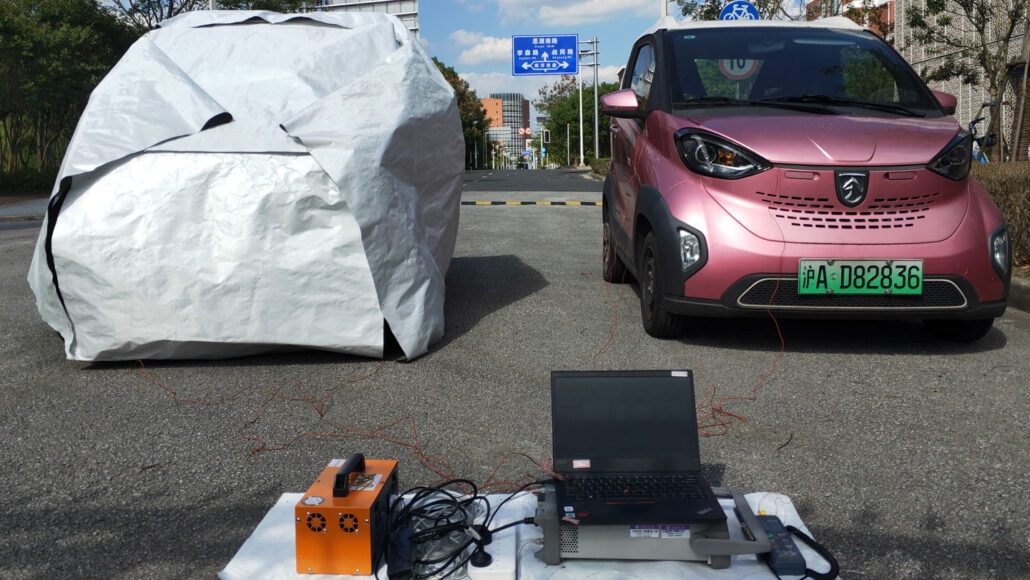New thermal ‘cloak’ keeps spaces from getting too hot or too cold
It could reduce the need for heating and cooling systems that emit greenhouse gases

The prototype fabric draped over the electric vehicle at left kept its inside temps up to 28 degrees Celsius (50 degrees Fahrenheit) cooler than the same-model uncovered car (right) on a summer day in Shanghai, China.
Huaxu Qiao
Share this:
- Share via email (Opens in new window) Email
- Click to share on Facebook (Opens in new window) Facebook
- Click to share on X (Opens in new window) X
- Click to share on Pinterest (Opens in new window) Pinterest
- Click to share on Reddit (Opens in new window) Reddit
- Share to Google Classroom (Opens in new window) Google Classroom
- Click to print (Opens in new window) Print
By Skyler Ware
This is another in our series of stories identifying new technologies and actions that can slow climate change, reduce its impacts or help communities cope with a rapidly changing world.
If you’ve ever burned your hands on a scorching hot seat belt buckle, you know how hot the inside of a car can get on a summer day. But a new fabric could one day help cars and other objects stay cooler in the summer — and warmer in the winter.
Researchers have just created a prototype of the fabric. It acts as a “thermal cloak.” That means it limits temperature changes in the space below it. And it requires no power source to do this. That means this cloak has the potential to cut the energy used for heating and cooling.
Globally, heating and cooling make up nearly four-tenths of energy use in buildings (38 percent). They add up to a little more than one-eighth (12 percent) of total energy used. Materials like this thermal cloak could cut those numbers while also keeping us more comfortable during heat waves.
That means such materials can cut the amount of carbon dioxide (CO2) released by burning fossil fuels to make the electricity that powers other types of cooling, says Aaswath Raman. He’s an applied physicist at the University of California, Los Angeles, who did not take part in the new study.
Kehang Cui is an engineer at Shanghai Jiao Tong University in China. For the new study, his team built a two-layered cloak. White silica fibers in the outer layer reflect visible light. This layer is coated with boron nitride. That’s a ceramic material. It reflects ultraviolet light and helps shed heat.
Together, the silica fibers and boron nitride reflected a whopping 96 percent of the sunlight that hit the fabric and would have contributed to warming. At the same time, the outer layer absorbed heat from the surrounding area. It then re-emitted that energy as infrared light. As heat left the site as radiation, the area under the cloak cooled even more.
That outer layer keeps space under the cloak cooler for longer than if it were uncovered. Still, the cloaked space slowly warms up during the day. The inner layer — made of aluminum foil — keeps this space warm at night by trapping some of that heat inside. It works like an insulating survival blanket.
Cui’s team shared details of its new cloak July 11 in the first issue of a new journal, Device.
It easily survives extreme conditions
The Shanghai team tested the cloak’s durability in several extreme environments.
For instance, they baked the fabric at 800° Celsius (1,470° Fahrenheit). That’s almost hot enough to melt table salt. The researchers also dunked the fabric in ultracold liquid nitrogen and subjected it to the same intensity of vibrations as a rocket launch. They even doused it in acid and blasted it with fire from a butane torch. In each case, there was virtually no change in the cloak’s structure or performance.
This extreme durability suggests the cloak might be useful in spacecraft or in extraterrestrial environments, the team says.
To test the fabric in action, Cui and his team built a full-size prototype cloak and wrapped it around an electric car. On a summer day in Shanghai, that cloak kept the car at around 23 °C (73.4 °F). That was as much as 8 degrees C (14 degrees F) lower than the outside temperature — and 28 degrees C (50 degrees F) cooler than the inside of an uncloaked car!
The wrap also kept the car about 5 degrees C (9 degrees F) warmer than the outside air on a winter night.
The cloak “definitely shows the capability of saving energy,” Cui says. “The next step is that we want to demonstrate it in even larger-scale field tests” — such as rooftops. He says that should help them to see “the impact on our daily lives.”






